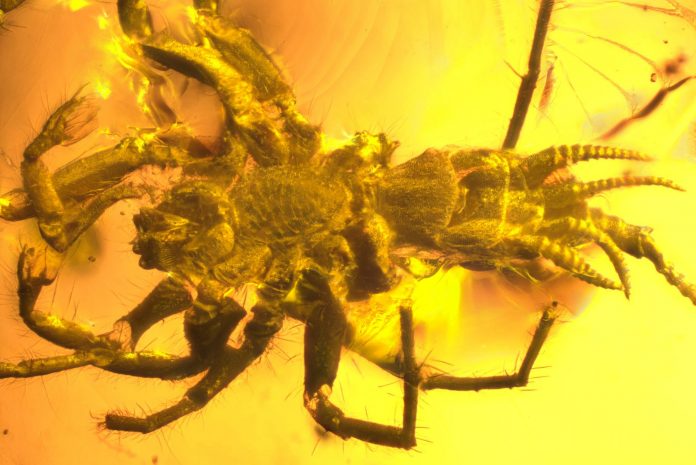
An ancient fossil from the Cretaceous period has been found, and it belongs to an eight-legged arachnid with a tail similar to a scorpion’s that lived 100 million years ago in Myanmar. It was given the name of Chimerarachne yingi given to the Greek mythological creature that carried the same name and possessed more than one common characteristic.
Four fossils were found intact and encased in amber and it is believed that it’s a missing piece that represents what perhaps might be the earliest branch of ascendance for spiders or Araneae. It is also believed however that this creature might have survived the Cretaceous period and fled into South East Asia, where it is believed by some scientists that the species may remain alive.
The unique tail has been one of the main subjects of interest, both in the University of Harvard and the Chinese Academy of Sciences in Nanjing have examined the fossils and came to the conclusion that based on how developed the silk making apparatus this creature belongs to the genus Uraraneida, which was to have gone extinct 275 million years ago.
Never before has there been a fossil showing spiders with tails. https://t.co/8jbsHH1dGn
— National Geographic (@NatGeoMag) February 7, 2018
Arachnids through history
Most primitive arachnids have a segmented abdomen, and most of them lost this segmentation during evolution. In this case, the Uraraneida is an extinct arachnid family spanning different periods, and four found fossils throughout the 20th and 21st centuries are the Attercorpus, Permarachne, Idmoarachne and finally the recently discovered Chimerarachne.
The fossils of the Uraraneida date back to the ages of Middle Devonian, Carboniferous, Permian and Cretaceous. The Uraraneida had been placed into the description of “Seirikodiastida” (Greek for silk workers) this places both Uraraneida and Araneae (spiders as we know them) in the same group that produces silk in their apparatus, which could mean that these two are part of the same “bloodline”.
It is believed that the tail was for sensorial purposes only, which means that spiders probably used to be crawling and hunting predators, but as evolution sought to change lifestyles, they became laidback sit-and-wait predators, so the tail was dispensed.
Spiders began using silk in order to wrap their eggs and line their constructed tunnels; however, this began much before the Monster Spider the most antique spider known. The newly discovered Chimerarachne apparently was small (less than half of an inch long), venomous as its glands show, had six eyes and four pairs of legs.
“We don’t know if it wove webs Spinnerets are used to produce silk but for a whole host of reasons – to wrap eggs, to make burrows, to make sleeping hammocks or just to leave behind trails. If they live in burrows and leave, they leave a trail so they can find their way back.”
Source: Popular Mechanics











